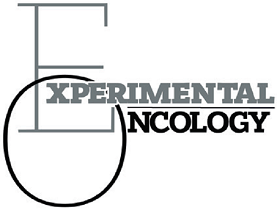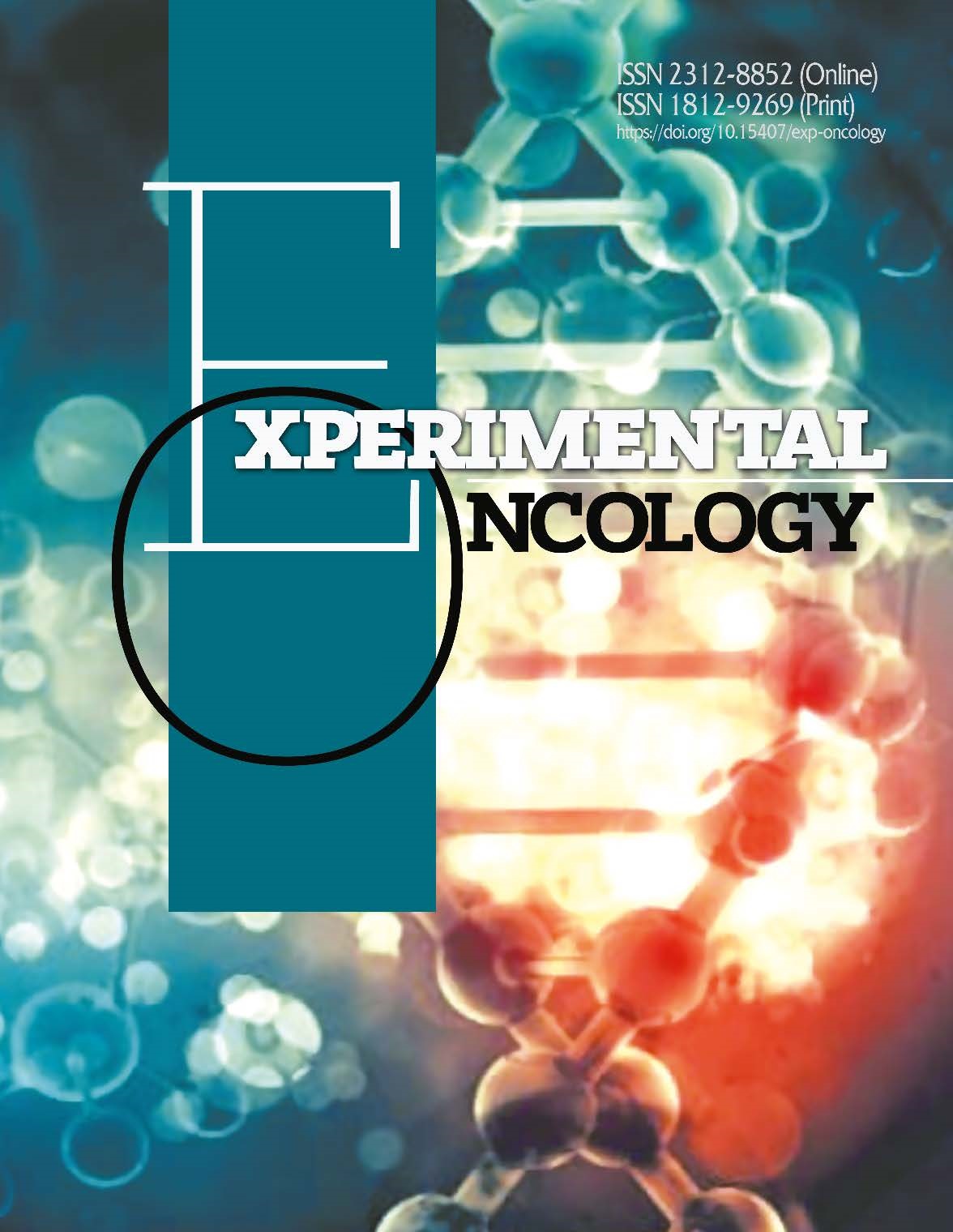ОПТИМІЗАЦІЯ ЕКСПЕРИМЕНТАЛЬНИХ МОДЕЛЬНИХ СИСТЕМ ДЛЯ ОЦІНКИ ВЗАЄМОВПЛИВУ BIFIDOBACTERIUM ANIMALIS ТА КЛІТИН РАКУ МОЛОЧНОЇ ЗАЛОЗИ ЛЮДИНИ IN VITRO
DOI:
https://doi.org/10.15407/exp-oncology.2023.04.504Ключові слова:
рак молочної залози, Bifi bacterium, мікробіота, крива росту, рН средовища, культура клітинАнотація
Стан питання. Відомо, що розвиток раку молочної залози (РМЗ) людини тісно пов’язаний з порушеннями нормального видового складу мікробіоти молочної залози. Бактерії роду Bifidobacterium є важливим компонентом нормальної мікробіоти грудей і володіють протипухлинною активністю. Молекулярно-біологічні механізми взаємовпливу клітин РМЗ і представників мікробіоти ще остаточно не з’ясовані. Метою цього дослідження було розробити та оптимізувати експериментальну модельну систему культивування клітин РМЗ з Bifidobacterium animalis in vitro. Матеріали та методи. Об'єктами дослідження були РМЗ клітини людини ліній MCF-7, T47D та MDA-MB-231, а також живі та інактивовані високою температурою бактерії виду Bifidobacterium animalis subsp. lactis (B. animalis). Кінетику росту та життєздатність B. animalis у присутності різних ліній клітин РМЗ людини та без них визначали методом турбідиметрії (OD600) та паралельним висівом на елективне поживне середовище. Споживання глюкози і продукцію лактату біфідобактеріями оцінювали біохімічними методами. Життєздатність клітин РМЗ визначали стандартним колориметричним методом. Результати. Кінетика росту B. animalis у повному поживному середовищі DMEM відповідала стандартним параметрам кривої росту бактерій. Показники споживання глюкози і продукції лактату B. animalis підтверджують їхню фізіологічну метаболічну активність за досліджених умов росту. Присутність клітин РМЗ в модельній системі не впливала на тривалість фаз росту популяції клітин B. animalis, але сприяла збільшенню їх кількості. Cтатистично достовірне зменшення кількості живих клітин РМЗ усіх досліджених ліній спостерігали лише через 48 годин співкультивування з живими B. animalis. Для досягнення подібного ефекту пригнічення життєздатності пухлинних клітин необхідне 10—30 кратне збільшення кількості інактивованих високою температурою бактерій у порівнянні з живими. Висновки. Ідентифіковано найбільш оптимальні умови співкультивування клітин РМЗ людини та живих клітин B. animalis in vitro.
Посилання
Álvarez-Mercado AI, Del Valle Cano A, Fernández MF, et al. Gut microbiota and breast cancer: the dual role microbes. Cancers. 2023;15:443. https://doi.org/10.3390/cancers15020443
Angelopoulou A, Warda AK, O’Connor PM, et al. Diverse bacteriocins produced by strains from the human milk microbiota. Front Microbiol. 2020;11:788. https://doi.org/10.3389/fmicb.2020.00788
Gueimonde M, Laitinen K, Salminen S, et al. Breast milk: a source of bifidobacteria for infant gut development and maturation? Neonatology. 2007;92:64-66. https://doi.org/10.1159/000100088
Laborda-Illanes A, Sanchez-Alcoholado L, Dominguez-Recio ME, et al. Breast and gut microbiota action mechanisms in breast cancer pathogenesis and treatment. Cancers. 2020;12:2465. https://doi.org/10.3390/cancers12092465
Wu H, Ganguly S, Tollefsbol TO. Modulating microbiota as a new strategy for breast cancer prevention and treatment. Microorganisms. 2022;10:1727. https://doi.org/10.3390/microorganisms10091727
Wei H, Chen L, Lian G, et al. Antitumor mechanisms of bifidobacteria (Review). Oncol Lett. 2018;16(1):3-8. https://doi.org/10.3892/ol.2018.8692.
Kim K-A, Jung I-H, Park S-H, et al. Comparative analysis of the gut microbiota in people with different levels of ginsenoside Rb1 degradation to compound K. PLoS ONE. 2013;8:e62409. https://doi.org/10.1371/journal.pone.0062409
Bindels LB, Neyrinck AM, Salazar N, et al. Non digestible oligosaccharides modulate the gut microbiota to control the development of leukemia and associated cachexia in mice. PLoS ONE. 2015;10:e0131009. https://doi.org/10.1371/journal.pone.0131009
Qi Y, Yu L, Tian F, et al. In vitro models to study human gut-microbiota interactions: Applications, advances, and limitations. Microbiol Res. 2023;270:127336. https://doi.org/10.1016/j.micres.2023.127336
Hwan Choi C, Il Kim T, Kil Lee S, et al. Effect of Lactobacillus GG and conditioned media on IL-1β-induced IL-8 production in Caco-2 cells. Scand J Gastroenterol. 2008;43:938-947. https://doi.org/10.1080/00365520801965373
Cruciani M, Sandini S, Etna MP, et al. Differential responses of human dendritic cells to live or inactivated Staphylococcus aureus: impact on cytokine production and T helper expansion. Front Immunol. 2019;10:2622. https://doi.org/10.3389/fimmu.2019.02622
Markowicz C, Kubiak P, Grajek W, et al. Inactivation of Lactobacillus rhamnosus GG by fixation modifies its probiotic properties. Can J Microbiol. 2016;62:72-82. https://doi.org/10.1139/cjm-2015-0249
Zhang L, Li N, Caicedo R, et al. Alive and dead Lactobacillus rhamnosus GG decrease tumor necrosis factor-α–induced interleukin-8 production in Caco-2 cells. J Nutrition. 2005;135:1752-1756. https://doi.org/10.1093/jn/135.7.1752
Blanchet F, Rault L, Peton V, et al. Heat inactivation partially preserved barrier and immunomodulatory effects of Lactobacillus gasseri LA806 in an in vitro model of bovine mastitis. Benef Microbes. 2021;12:95-106. https://doi.org/10.3920/BM2020.0146
Castro-Herrera VM, Rasmussen C, Wellejus A, et al. In vitro effects of live and heat-inactivated Bifidobacterium animalis subsp. lactis, BB-12 and Lactobacillus rhamnosus GG on Caco-2 cells. Nutrients. 2020;12:1719. https://doi.org/10.3390/nu12061719
Goers L, Freemont P, Polizzi KM. Co-culture systems and technologies: taking synthetic biology to the next level.
J R Soc Interface. 2014;11:20140065. https://doi.org/10.1098/rsif.2014.0065
Abu-Taraboush HM, Al-Dagal MM, Al-Royli MA. Growth, viability, and proteolytic activity of Bifidobacteria in whole camel milk. J Dairy Sci. 1998;81:354-361. https://doi.org/10.3168/jds.S0022-0302(98)75584-5
Neve RM, Chin K, Fridlyand J, et al. A collection of breast cancer cell lines for the study of functionally distinct cancer subtypes. Cancer Cell. 2006;10:515-527. https://doi.org/10.1016/j.ccr.2006.10.008
Stevenson K, McVey AF, Clark IBN, et al. General calibration of microbial growth in microplate readers. Sci Rep. 2016;6:38828. https://doi.org/10.1038/srep38828
Karbowiak M, Gałek M, Szydłowska A, et al. The influence of the degree of thermal inactivation of probiotic lactic acid bacteria and their postbiotics on aggregation and adhesion inhibition of selected pathogens. Pathogens. 2022;11:1260. https://doi.org/10.3390/pathogens11111260
Holkem AT, Robichaud V, Favaro-Trindade CS, et al. Chemopreventive properties of extracts obtained from blueberry (Vaccinium myrtillus L.) and jabuticaba (Myrciaria cauliflora Berg.) in combination with probiotics. Nutrit Cancer. 2021;73:671-685. https://doi.org/10.1080/01635581.2020.1761986
Fernández M, Reina-Pérez I, Astorga J, et al. Breast cancer and its relationship with the microbiota. IJERPH. 2018;15:1747. https://doi.org/10.3390/ijerph15081747
Wang H, Altemus J, Niazi F, et al. Breast tissue, oral and urinary microbiomes in breast cancer. Oncotarget. 2017;8:88122-88138. https://doi.org/10.18632/oncotarget.21490
Ruiz L, Delgado S, Ruas-Madiedo P, et al. Bifidobacteria and their molecular communication with the immune system. Front Microbiol. 2017;8:2345. https://doi.org/10.3389/fmicb.2017.02345
Tripodi L, Feola S, Granata I, et al. Bifidobacterium affects antitumor efficacy of oncolytic adenovirus in a mouse model of melanoma. iScience. 2023;26:107668. https://doi.org/10.1016/j.isci.2023.107668
Pham VT, Mohajeri MH. The application of in vitro human intestinal models on the screening and development of pre- and probiotics. Benef Microbes. 2018;9:725-742. https://doi.org/10.3920/BM2017.0164
El Houari A, Ecale F, Mercier A, et al. Development of an in vitro model of human gut microbiota for screening the reciprocal interactions with antibiotics, drugs, and xenobiotics. Front Microbiol. 2022;13:828359. https://doi.org/10.3389/fmicb.2022.828359
González-Rodríguez I, Ruiz L, Gueimonde M, et al. Factors involved in the colonization and survival of bifidobacteria in the gastrointestinal tract. FEMS Microbiol Lett. 2013;340:1-10. https://doi.org/10.1111/1574-6968.12056
Yonezawa S, Xiao JZ, Odamaki T, et al. Improved growth of bifidobacteria by cocultivation with Lactococcus lactis subspecies lactis. J Dairy Sci. 2010;93:1815-1823. https://doi.org/10.3168/jds.2009-2708
Gao P-P, Liu H-Q, Ye Z-W, et al. The beneficial potential of protein hydrolysates as prebiotic for probiotics and its biological activity: a review. Crit Rev Food Sci Nutr. 2023;1-13. https://doi.org/10.1080/10408398.2023.2260467
Janer C, Arigoni F, Lee BH, et al. Enzymatic ability of Bifidobacterium animalis subsp. lactis to hydrolyze milk proteins: identification and characterization of endopeptidase O. Appl Environ Microbiol. 2005;71:8460-8465. https://doi.org/10.1128/AEM.71.12.8460-8465.2005
González-Rodríguez I, Gaspar P, Sánchez B, et al. Catabolism of glucose and lactose in Bifidobacterium animalis subsp. lactis, studied by 13 C nuclear magnetic resonance. Appl Environ Microbiol. 2013;79:7628-7638. https:// doi.org/10.1128/AEM.02529-13
Sánchez B, Champomier-Vergès M-C, Stuer-Lauridsen B, et al. Adaptation and response of Bifidobacterium ani- malis subsp. lactis to bile: a proteomic and physiological approach. Appl Environ Microbiol. 2007;73:6757-6767. https://doi.org/10.1128/AEM.00637-07
Bondue P, Delcenserie V. Genome of bifidobacteria and carbohydrate metabolism. Kor J Food Sci Animal Resources. 2015;35:1-9. https://doi.org/10.5851/kosfa.2015.35.1.1
Michl J, Park KC, Swietach P. Evidence-based guidelines for controlling pH in mammalian live-cell culture systems. Commun Biol. 2019;2:144. https://doi.org/10.1038/s42003-019-0393-7
Pokusaeva K, Fitzgerald GF, Van Sinderen D. Carbohydrate metabolism in Bifidobacteria. Genes Nutr. 2011;6:285–306. https://doi.org/10.1007/s12263-010-0206-6
Adamberg S, Sumeri I, Uusna R, et al. Survival and synergistic growth of mixed cultures of bifidobacteria and lactobacilli combined with prebiotic oligosaccharides in a gastrointestinal tract simulator. Microb Ecol Health Dis. 2014:25. https://doi.org/10.3402/mehd.v25.23062
Chen J, Chen X, Ho CL. Recent development of probiotic bifidobacteria for treating human diseases. Front Bioeng Biotechnol. 2021;9:770248. https://doi.org/10.3389/fbioe.2021.770248
Pérez-Tomás R, Pérez-Guillén I. Lactate in the tumor microenvironment: an essential molecule in cancer progression and treatment. Cancers. 2020;12:3244. https://doi.org/10.3390/cancers12113244
Żeromski J, Kaczmarek M, Boruczkowski M, et al. Significance and role of pattern recognition receptors in malignancy. Arch Immunol Ther Exp. 2019;67:133-141. https://doi.org/10.1007/s00005-019-00540-x
##submission.downloads##
Опубліковано
Як цитувати
Номер
Розділ
Ліцензія
Авторське право (c) 2024 Експериментальна онкологія

Ця робота ліцензується відповідно до Creative Commons Attribution-NonCommercial 4.0 International License.



